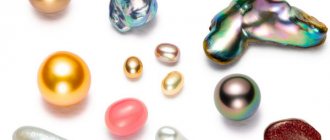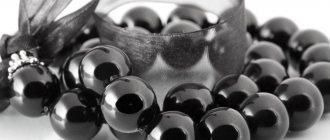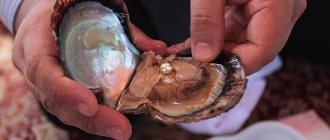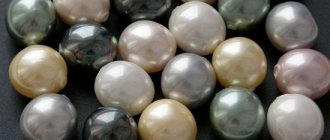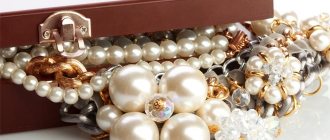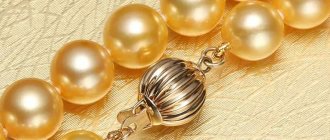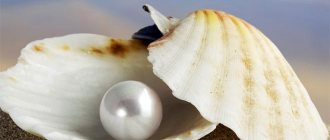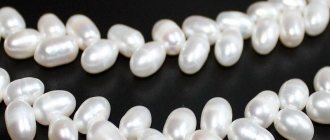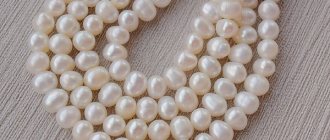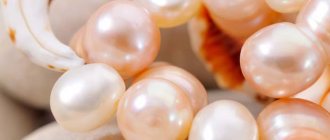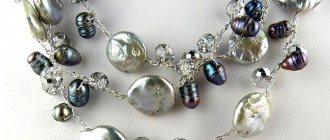The smoothest and most beautiful pearls are used to make necklaces, bracelets and other jewelry. The popularity of pearl products is very high. Fashionistas love the warm, mesmerizing color of iridescent pearls. There is something enchanting and mysterious about it. Pearls give their owners health and longevity. But it can die if it is not properly cared for and stored. Mother of pearl is very sensitive to ultraviolet radiation, humidity, and chemical compounds.
There are river and sea pearls. River is extracted from clean rivers, sea from the bottom of the sea. Fishing is a method of extracting pearls from mollusk shells.
Fishing method in the Gulf of Manara
The places where pearl mussels gather are on the sandbanks. Fishing begins in March, when there are no storms. The entire bay is divided into equal sections, and mining is carried out in one of the sections to prevent depletion of shellfish stocks. Fishing begins when a certain number of pearl mussels accumulate. The fishery is monitored by supervisory authorities. Collection of shells from the seabed is carried out mainly by hand by divers. These are people who are taught by their parents from an early age. They extract shells without special equipment. The shells are brought ashore and most are rented to the government, the rest are divided among the divers, helpers and the boat owner. People who buy shells put them in special containers and leave them in the sun for several days. Parts of the shellfish rot and people take out large pearls, then collect small pearls by washing parts of the shellfish.
Magic properties
Pearls owe their magical properties to the Moon. But they do not share this strong energy with everyone, but only with a select few. This cannot be done without the influence of Venus and Neptune, which endowed white beads with the ability to attract the attention of others to their owner.
View this post on Instagram
Posted by Silver Leto (@silver_leto) Aug 14, 2021 at 2:45 PDT
A few interesting factors:
- Women in Ancient Greece believed that it was necessary to buy pearls before getting married, so that this amulet would help bring them together with a faithful person.
- In the Middle Ages, pearls were considered tears shed by innocent children and souls. They were used to decorate wedding attire, as they believed that this would strengthen the union of two hearts.
Why should you always carry freshwater pearls and their jewelry with you?
- Helps you make new useful contacts. True friends who will never leave you in trouble.
- A person becomes calmer and is capable of making the right decisions, adequately assessing the current situation.
- Pearls help to find peace and beauty (both external and internal).
- Prolongs life and makes it happier.
- Gives strength and self-confidence.
Only those who are not afraid of change and confidently move towards their goal will be able to feel the magical effects of freshwater pearls. The mineral chooses those who are ready to act quickly when needed, following their heart. Indecisive people and those who are not responsible for their actions are not recommended to wear pearls, because it can even cause harm.
It is believed that if there is no love, respect and mutual understanding in a family, then pearls fade and do not flicker in the sun.
Islands of Bahrain and Qatar
High quality sea pearls of a soft pink hue are mined here. Divers extract shells from a depth of 15 meters. The only clothing is a loincloth; the nose is pinched with a bamboo clothespin. She collects the shells in a wire basket. An assistant remains in the boat and lifts the basket. If the team leaves for several days, then a singer goes with them, who entertains the catchers by singing songs. Hard work and prolonged exposure to salt water lead to exhaustion of the body and early death of pearl divers. For this reason, pearls are called “tears of the bay.” Production has decreased due to artificial methods of pearl cultivation and the discovery of oil production in the regions.
Medicinal properties
Wearing jewelry with pearls will have a positive effect on:
- state of the nervous system;
- vegetative;
- lymphatic;
- the work of blood vessels and the heart (it is customary to put a ring with a stone on the ring finger of the right or left hand).
View this post on Instagram
Publication from WEDDING, EVENING DECORATION (@asira_official_) January 21, 2021 at 7:19 PST
How to charge water with a pearl?
- Drop a few pearls into a glass of water.
- Let it sit in a dark place for 12 hours.
This infusion helps normalize the body's production of blood cells. If you have any inflammation, it will gradually decrease.
Socotra Island and Gulf of Aden
They are famous for their rare pearls with a lead tint. Pearls are also obtained in the old way with the help of divers. Since the sea in these places is teeming with sharks, fishing is carried out only during the season when there are fewer of them. The swimmer's equipment consists of a diving weight and a basket for shells. To examine the bottom, use a special mirror, which represents a box with a glass bottom. The bottom of the sea is visible from the boat, and the swimmer descends behind the shells. In order not to breathe, a clothespin made of a cow's horn is put on the nose. This is a tribute to centuries-old traditions, since children inherit the work of their parents.
How to distinguish from a fake
Nowadays, the jewelry market increasingly comes across a fake, which is a ball of plastic or glass covered with a layer of artificial mother-of-pearl. As a rule, such specimens are used to make cheap jewelry, but sometimes unscrupulous manufacturers pass them off as natural river pearls. The following techniques will help you distinguish fakes from the original:
- Rub the stones against each other: natural products will cling and squeak, while artificial ones will slide.
- Just hold the beads in your hand, they have a noticeable weight and are cool to the touch, and the counterfeit is almost weightless.
- Look at the holes in the beads: the original has uneven edges, layers of mother-of-pearl can be seen, but the fake has perfectly smooth walls, and the bead is empty inside.
- Throw a stone onto a flat surface: natural stone will bounce, but synthetic stone will roll.
These are the main differences between real freshwater pearls and fake ones.
In addition, you should remember that natural mother-of-pearl beads cannot be cheap.
Australia
Pearl fishing is carried out in the Torres Strait, and fishing is also carried out along the entire north-west coast. Australians have adopted the Japanese method of growing pearls on special farms, and now it is a full-fledged industry that brings in good income. Pearls grow faster and larger here than in Japan.
Previously, the waters of the seas and oceans were abundant in pearls, but now the reserves have been sharply depleted. This happened due to predatory fishing, when tons of shells were destroyed for the sake of one pearl. Environmental changes and pollution of the seas and oceans have led to the death of many shellfish.
Who is suitable according to their zodiac sign?
The element of freshwater pearls is Water. Therefore, it is ideal for water and air signs of the Zodiac.
To whom freshwater pearls will bring good luck:
- Pisces. Women will find their soul mate and build a happy marriage. All owners of the sign will become more rational, decisive and reasonable.
- Aquarius. It will help you get rid of the negative influence of others and not pay attention to minor problems that prevent you from achieving your main goal. It will also have a positive effect on the psyche. People will be less exposed to stress and neuroses. To pull yourself together, just hold the pearls for 10-15 minutes. Also, it pushes people to make the right decisions.
- Gemini. Gives you self-confidence, promotes career growth and helps you achieve your goals.
- Taurus. Gain calmness and confidence.
- Scorpios. They will be able to cope with their not the best qualities.
- Cancers. Freshwater pearls will suit them not only as a talisman, but also as a medicine (it will relieve overwork and heart problems).
- Scales. They will begin to look at things and perceive the world around them easier.
Who is the mineral not suitable for?
Astrologers note that pearls are not the best talisman for such zodiac signs as Aries, Sagittarius and Leo. Also, it is not suitable for Virgos who are very afraid of something. Otherwise, their fear may only increase.
Extraction in Japan: cultured pearls
The price of natural pearls has dropped dramatically since cultured pearls began to be grown in Japan. The Japanese adopted technology from China, who tried to grow pearls artificially thousands of years ago. They placed small pieces of baked clay, bone or copper between the shell flaps. The shells were returned to the lake for 2-3 years. Mother-of-pearl figures were formed. They also placed miniature images of Buddha.
Many European and Russian scientists were engaged in growing artificial pearls, but only the Japanese K. Mikimoto patented his invention and created a pearl farm. It took years of hard work to achieve a good result. Initially, Mikimoto pearls were not of jewelry quality. Over time, he came up with the latest technology, which made it possible to obtain good pearls of the desired shape and shine. Their cultivation is quite capable of competing with natural sea pearls.
Now Japan is the undisputed leader in the cultivation of cultured pearls. There is Mikimoto Island, where there is a museum and a laboratory for growing pearls.
Pearl shapes
Depending on the location of the introduction of the foreign body, pearls are formed in various shapes:
- Spherical or round - formed in the center of the shell, the most valuable;
- Hemisphere - valued almost as much as round ones, widely used in jewelry;
- Rice - flattened ones develop in contact with the walls of the shell;
- Drop-shaped - often used in the manufacture of earrings, pendants and pendants;
- Baroque is a stone of irregular abstract shape. Some particularly fancy specimens are valued even higher than the round ones;
- Semi-baroque - the shape is closer to round, but asymmetrical.
Pearls of the South Seas... and rivers. Or everything I wanted to know about pearls, but had no one to ask
Well, first of all, Happy New Year, of course! And Merry Christmas! All the most joyful, warm, homely and cozy wishes to you! And also - health, good luck, kindness and a lot of joy! And so that there is enough money for everything, and so that the day becomes rubber and contains everything you love! And so that your loved ones are happy, and so that the house is cozy, so that children, cats, and dogs walk in front of the house! And so that everyone loves each other :-):-):-)
At first I was just thinking about a New Year’s post, and then I decided that it would be better and more interesting for you if I finally push myself and fulfill my promise - I’ll write a post about pearls. So, I’m doing it :-)
As I mentioned, much of my Philippine vacation was spent in a hotel bed, gagged, and taking pills instead of breakfast, lunch, and dinner. But still, one cannot say that this time was completely lost - the Internet was accessible;-)
And I took advantage of this circumstance to finally sort out the questions about pearls that had been hanging around in my head for a long time, but somehow did not find clear answers. The conclusions that I want to share with you in this post are not just the knowledge gained on the Internet, but also personal experience and impressions from visiting the Green Hills pearl market in Manila, conversations with traders and my own observations and comparisons. I'll start in order. I have been wondering about pearls for a long time. And the information that could clarify them was either very vague or terribly contradictory. When going to the Philippines, I knew in advance that I was going to places where South Sea pearls are grown, where they are plentiful and cheap. Therefore, I decided to clarify all my questions, if possible, right on the spot. Since my fate sent me to the islands to get sick, I had enough time for, so to speak, theoretical preparation - that is, surfing the Internet (luckily wifi reached the number and was free), reading various sources and looking pictures.
The main question that has occupied me for a long time and thoroughly is the difference in price. It’s true, why are freshwater pearls tens of times cheaper than sea pearls? I figured it out. I'm sharing. The most important difference is in the growing technology. The shells in which river, or rather freshwater, pearls are grown are quite unpretentious. They do not require a certain depth, they are not too sensitive to temperature changes, and can live normally both in running water and in almost stagnant water.
The freshwater pearl mussel lives up to 30 years, and during this time several “generations” of pearls can grow in it - usually pearls “mature” for three to five years. By the way, do you know how many pearls one freshwater shell usually “bears”? Believe it or not, 15-20 is the norm, and sometimes it even happens up to forty!!! I was once at a pearl farm in China, and there a girl guide played with us in a kind of sweepstakes - whoever accurately guessed how many pearls were in the shell would receive the entire “harvest” as a gift. Our group got a pearl oyster with 17 grains. But the sea pearl oyster can most often “give birth” from one to three pearls at a time, and extremely rarely - five. And a seashell lives only 6-10 years.
But the price of sea pearls is higher not only because of this. The growth rate of sea pearls is noticeably higher than that of river pearls, but... But! Sea pearl mussels are terribly capricious - they must certainly live at a certain depth, in water with a constant chemical composition and temperature. If, for example, the temperature of the water around it drops by a couple of degrees, the mollusk secretes some kind of acid, and the pearls in it spoil hopelessly! And with more serious temperature fluctuations, changes in water composition or during storms, pearl mussels even die!
It turns out that growing saltwater pearls is a much riskier endeavor than a freshwater pearl farm. Plus, the operation itself of “implanting” a pearl for seashells is more complicated: to obtain a freshwater pearl, it is enough to place a small piece of meat of another similar mollusk into an incision on a mollusk. The pearl oyster will begin to envelop this foreign formation with nacre, and after some time it will produce a pearl. With a sea shell it's different. First, you need to place the same piece of someone else’s fabric in it, and only then - the grain, which it will begin to envelop in mother-of-pearl. If you put grain without “meat”, nothing will happen. If the “meat” is without grain, then that’s also not a fact!
At the same time, a sea mollusk, as we remember, can grow no more than five pearls at a time. And besides, much more often it “spits” implanted nuclei, spoils already grown pebbles, or even dies. This is how it turns out that sea pearls are almost always much more expensive than their freshwater counterpart.
But sea shells have one feature that adds to their attractiveness and charm. The natural colors of sea pearls are much, much more diverse than those of river pearls.
As we were told at the Chinese farm, freshwater pearls in nature can only be white, pink and dark (dark-dark gray). Moreover, it grows white in completely fresh, clean water, pink - in water with copper salts, and dark - if iron salts are present there. The color of sea pearls partly depends on the type of mollusk (and there are as many as five main types of pearl oysters), and also on their living conditions. Natural colors of sea pearls include white with all shades, yellow-gold, green, pink, black, and even blue. The Chinese island of Hainan is famous for its green sea pearls, and the Philippine Islands, in particular Panay, are famous for their golden pearls.
I am trying to present in this note only what I was able to touch with my hand and see with my own eye, so I will not dwell on Akoya pearls, Tahitian black pearls, expensive abalone - until I was able to observe them, so to speak, in my native places. Maybe I’ll be lucky... But I saw South Sea pearls in commercial quantities, touched them, and asked about them. I also sifted through a bunch of materials from the Internet while I was lying sick in a Philippine hotel, and when things got better, I went to the pearl merchants and tried to empirically test everything I had read about.
Thus, through experience, I realized that it is almost impossible to distinguish a sea pearl from a high-quality river pearl. Those who undertake to assert the opposite either have not seen high-quality freshwater pearls, or have not had the opportunity to place its sea “sister” next to such a pearl. Of course, I cannot guarantee that the same will happen with Akoya or Tahitian pearls, but I personally held the famous South Sea pearls in my hands, and I stand behind my words!
To be honest, I didn’t think it was so! But it is not without reason that the main recommendation for accurately establishing the origin of a pearl is to illuminate it with an X-ray. The X-ray image will clearly show the nucleus, which a sea pearl will certainly have. Freshwater pearls are almost always grown without a core. The only exception I know of is Kasumi. These are freshwater pearls, which were invented to be cultivated in Japan, and now the technology has spread throughout almost all of Asia.
It is interesting that precisely because of the lack of a nucleus, river pearls are practically never as large as South Sea pearls. Its normal (!!!) diameter is 15-18 mm. It’s not easy to stuff such a bandura into an average river shell - a freshwater pearl mussel is not very large, about half the size of an adult’s palm at most. The nuclear-free method of growing freshwater pearls makes them less capricious, but due to the lack of a nucleus, river pearls are much more likely to be uneven. And for some reason, mother-of-pearl on them, as a rule, does not lie in such even layers as on sea pearls. Therefore, if you compare a sea pearl of average quality with a river pearl of approximately the same quality, the sea pearl will look much rounder and smoother. I don’t know exactly why this happens, but pearl sellers in both Hainan and the Philippines told me about it. Yes, another interesting point - even baroque sea pearls, far from being spherical, are still much less fancy and have a rounder shape than freshwater “baroque”. So, if you see something that is large, almost perfectly round, evenly colored, and appears to be of natural origin, then it is likely to be a sea pearl.
But it is unlikely that it will be possible to distinguish sea pearls from river pearls by color. Although, as I already mentioned, the natural color palette of sea pearls is much wider than that of river pearls, now you can easily find freshwater pearls of almost any shade. At the same time, there are both openly dyed threads and options indistinguishable from natural ones. The point here is that, to give the desired shades, pearls are often treated in rather sophisticated ways - irradiated, placed in a chamber with different gases, etc., and not simply applied with a layer of color.
When I tried to shop for pearls at Green Hills in Manila, salespeople regularly asked me what my budget was. It's funny that they could pick up a string of pearls of almost any color for tens of dollars, and hundreds, and thousands and tens of thousands. At the same time, I could not always guess “at a glance” the cost of this very thread. Do you think I wasn't looking carefully? But no, she looked, asked to give it to her, and brought it to her very nose. And I couldn’t always “find ten differences”! So, I can now confidently say that the words that sea pearls are not at all similar to river pearls are, to put it mildly, a misconception. It is not for nothing that it is now believed that the only reliable way to establish the origin of a pearl is an X-ray image. And nothing else.
The only way to somehow identify sea pearls purely externally, which I risk using, is by size and shape. As I already mentioned, South Sea pearls are very large. Accordingly, if I came across a string of large, evenly colored and round pearls, then most often they were sea pearls. Here, for example, is my “prey”. In the photo side by side there are freshwater baroque pearls and a string of sea pearls, also baroque:
The same pearls, but close-up:
These are all Philippine pearls. Can you guess which one is marine?
Alas, I must repent: most of the photos in this post are not mine. Well, the prey is mine, of course. But for a long time I was looking for exactly the kind of photos that would correspond not only to the text, but also to what I happened to see. Alas, alas, being in the Philippines I did not take good care of the illustrations - I had to get them here.
